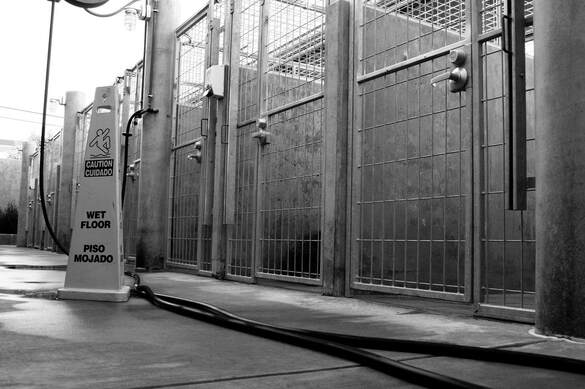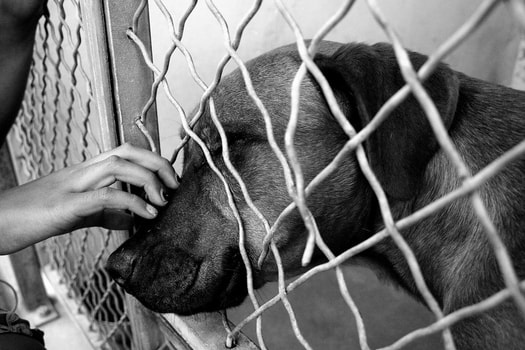|
I had a conversation with some of my contacts in the national No Kill community recently about the toll taken at shelters where healthy and treatable animals are destroyed. We started talking about it after an article was written by some big thinkers in the animal shelter industry called “The Human Face of Shelter Euthanasia.” Some of the content of the article troubled me and for some reason the article is not available, at least not now. The article and our conversation got me thinking about the changes I have seen in the shelter industry in the last fifteen years - at least in some places - and how the culture in shelters affects not just the animals, but the people in the building and the community as a whole. The best way to explain this is with two examples. Shelter A is a kill shelter which means that healthy and treatable animals are killed for space, convenience or what some call “lack of resources.” This means that animals who are suffering are euthanized and dogs who are too dangerous to be out in the community are destroyed, but the lives of animals who are otherwise healthy and treatable are also ended. There are a number of excuses used for this, but the end result is the same because the act is permanent. The general mindset at this shelter is that it is the fault of the public that animals “have to" die. Employees and volunteers tell themselves there is no other way because the public just does not care enough. They say that if the public would only keep pets contained, spay and neuter pets, stop breeding animals, be more responsible, etc., the shelter would not be forced to end so many lives. Some of the people in this shelter take great pride in how they treat the animals prior to ending their lives, spending extra time with them or giving them special food or treats much like a death row inmate may receive a last meal. Most shelter employees lament the death, but tell themselves there are fates worth that death like adopting to a “less than” family (which means a family which does not meet all of the shelter criteria to adopt) or like having the animals develop negative behaviors while in the shelter due to stress. I see these attitudes as a form of cognitive dissonance. The toll taken by the killing in this shelter is paid 1) by the healthy and treatable animals who should have and could have been saved; 2) by the people who work in the shelter and who have either engaged with the animals are who are tasked with ending their lives; 3) and by the community as a whole. This shelter is seen by the public not as a place of hope, but as a place of death. People do not want to go there, do not want to take their children there, and for the most part do not want to volunteer there because it is emotionally easier to just distance themselves from what happens at the shelter than to deal with the death. They just can't handle it and feel powerless to do anything about it. Shelter B is a No Kill shelter which means healthy and treatable animals are not destroyed. Animals who are suffering or are irremediably ill are euthanized for reasons of mercy. Dogs who are genuinely dangerous to the public are also euthanized because they are considered untreatable (as opposed to dogs who have mild to moderate behavior issues who can be rehabilitated, fostered and adopted into homes). In this shelter, each animal is treated as an individual and is viewed as having been - or being capable of being - someone’s beloved pet. The shelter staff works incredibly hard every day to keep pets in existing homes to avoid them entering the shelter, to provide enrichment and care to those animals in the shelter and to get animals out into foster homes, adoptive homes or to rescue groups as soon as possible. For this shelter, the public is not the enemy. The public is presumed to care and to sometimes need help and guidance either to make better personal decisions or to learn how to help the shelter. The shelter communicates on an ongoing basis with the public to help them keep pets contained, find lost pets, make sure pets can be identified, overcome problem behaviors, locate resources in the community (food, veterinary care, spay/neuter assistance and behavioral help), learn how to foster pets, learn how to volunteer to help pets, learn how to adopt pets and about pets who are at risk and need to get out of the shelter immediately because they are doing poorly in the shelter environment. The people who work in this shelter have incredibly difficult jobs, but they take pride in what they do. Each day is a new opportunity to help animals in need while serving the community. There is sorrow when the lives of shelter animals are ended, but staff and volunteers are confident that each animal euthanized was given every opportunity to leave the shelter alive, they did their very best to find a positive outcome and the ending of the life was done for reasons of mercy. I work in a community where the shelter was once like Shelter A and is now like Shelter B. The transition from a shelter which had historically destroyed thousands of healthy and treatable animals each year to one where very few animals die each year has been nothing short of remarkable. This transition did not happen because the public suddenly became more responsible or cared more or made better choices. The transition was at times incredibly difficult and it made a lot of people uncomfortable. It’s hard to admit that there is a new way of functioning while not focusing on the past and what could have been. Change happened as a result of municipal leadership, advocacy and public pressure and it has led to a complete shift in culture at the animal shelter. Are there still issues? Sure. Is there fine tuning to be done? Absolutely. But a building which was once used to house and then destroy animals is now used to house animals and keep them alive. When I think of how the shelter functioned before, I know the operation was fatal for so very many animals, detrimental to the mental, emotional and likely the physical health of the staff, and was a source of shame in an otherwise very progressive community. But all that is in the past. Now the shelter is a place of hope instead of death. People in the community turn to the shelter for help, guidance and assistance. Working and volunteering there is still a challenge because the work is really hard, but it is also rewarding which means the people who manage and help the operation are happier. I have been told that the pressure to keep up the level of life-saving is intense and I’m sure it is. The public has come to expect that animals will be kept alive now that a higher standard has been achieved. There are still critics and there always will be, but the way in which the shelter operates is now a source of community pride. What kind of shelter do you want for your community? A or B? I know the price. I know the toll. I know my choice. (Images courtesy of Erick Pleitez and Lisa Vallez)
2 Comments
9/13/2021 08:19:09 am
In Burke County and other NC counties, The Dept of Agriculture is responsible fot the deaths of thousands of cats. How so? They threaten to close down any shelter that is overcrowded. Happens on a regular basis.
Reply
Paws4Change
9/13/2021 01:19:44 pm
It is clear that some places in the state do better than others. Burke County is on the regressive end and Avery County (by way of example) is on the progressive end of the spectrum. When there is this much difference between communities in a state, it does beg the question of what people on the poorly performing places are doing to seek change. It often falls on advocates and members of the public to say, "enough. We are better than this." I hope some folks there will rise to the challenge.
Reply
Your comment will be posted after it is approved.
Leave a Reply. |
AuthorI am an animal welfare advocate. My goal is to help people understand some basic issues related to companion animals in America. Awareness leads to education leads to action leads to change. Archives
July 2024
Categories
All
image courtesy of Terrah Johnson
|



 RSS Feed
RSS Feed